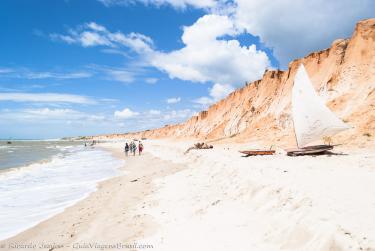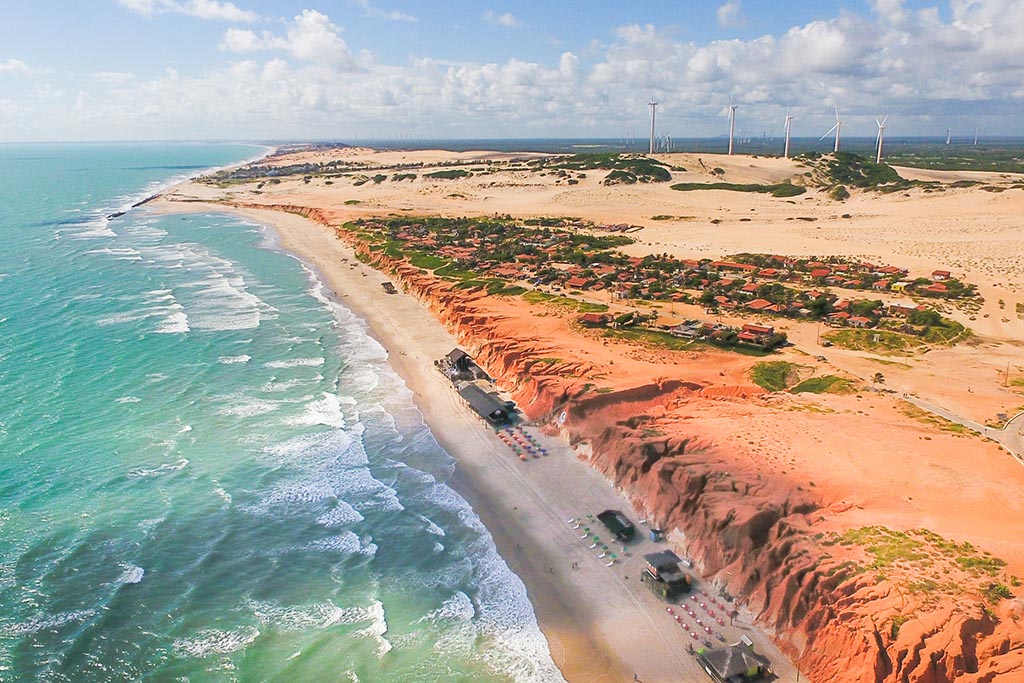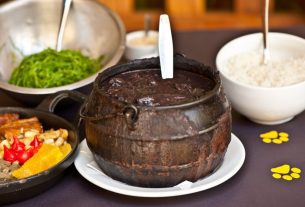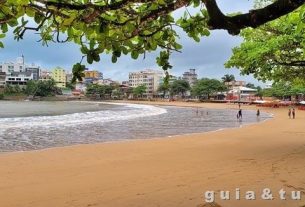The beaches of Aracati stand out as the most beautiful and best preserved in the country. Starting with the most famous, Canoa Quebrada is considered an example of natural wealth as it is surrounded by cliffs and transparent sea. In fact, this is nothing new, almost all the beaches in the region have untouched scenery with dunes, white sand, red cliffs and blue-green sea. Some suitable for surfing, others for kitesurfing and others for swimming, there are beaches for all styles, always surrounded by fishing villages. The busiest and most well-structured is Canoa Quebrada, the other countless beaches in the surrounding area are more remote and wild.
Canoa Quebrada Beach

Photo of Canoa Quebrada Beach, in Canoa Quebrada, CE
Photo Credit: © Ricardo Junior Fotografias.com.br
The central and most visited beach is marked by reddish cliffs that surprise with their beauty and grandeur. The famous image of a moon and star in the sand comes from this beach, praised throughout the world. The tents on the shore are also the attractions of this beach, which receives numerous visitors throughout the year. On the left are the trendiest kiosks with live music, while on the right you will find more tranquility. In the summer there are often luaus on the beach, attracting tourists.
See the Canoa Quebrada Beach photo gallery
Majorlândia Beach
This fishing village stands out for the rich handicrafts produced there, such as traditional bottles with colored sand. Coconut trees and cliffs make up the beauty of the beach, along with the stalls serving tasty delicacies. The sunset at Morro do Urubu is one of the most recommended. It is 8 km from Canoa.
Ponta Grossa Beach
This beach attracts attention as it is home to multicolored cliffs, reefs, dunes, green sea, rocks and also a fishing village. It is one of the most beautiful in the region.
It is further away, 54 km from Canoa.
Fontainha Beach
The beach is home to fine, clear sand, cliffs and blue sea with strong waves. At high tide, the sea can advance through the sand.
Lagoa do Mato Beach
Further away and with a wild appearance, it pleases many tourists with its dunes and coconut trees. The calm waters surrounded by corals favor diving at low tide. Here is the Devil’s Throat, a well-known stretch between red cliffs.
Ceará Beach
The shore is made up of carnaub trees, a tree typical of the northeast and some kiosks. It is located right on the border with Rio Grande do Norte.
Redondas Beach
Extensive and with strong waves, it attracts tourists and surfers. It has a deserted stretch to the west with cliffs and reefs. It is in a fishing village.
Retirinho Beach
Wild and paradisiacal, it combines light sand with rocks, small colorful dunes and even a freshwater fountain. The sea is open.
Retiro Grande Beach
The extensive strip of sand covered in rocks and algae and the sea with reefs protruding into the sand favor the arrival of buggies.
Barreiras Beach
Made up of reefs and cliffs, it has calm coves. Access is via the road to Mutamba.
Manibu Beach
Also called Praia do Arrombado, the coconut trees stand out around it, the beauty is due to the lagoons that cut through the region. It is two kilometers long.
Peixe Gordo Beach
With dark sands, it is surrounded by lagoons, which favors fishing in the shallow sea.
Peroba Beach
The long, clear sand combines perfectly with the strong waves of this fishing village. The rough sea encourages surfing.
Quixaba Beach
The calm sea, away from movement, favors fishing in the village. Cliffs are found in the surroundings.
Tremembé Beach
A fishing village is located here and stands out for selling handicrafts. Access is difficult, but it is worth it due to the beautiful salt flats.
Pontal de Maceió Beach
Unspoiled, this beach is in a fishing village. It has clear, soft sand and a clear, almost transparent sea.
Icapuí Beach
Although it is not recommended for bathing, it is perfect for kitesurfing. Around a vast mangrove area completes the view.
Canto da Barra Beach
This extensive beach stretches from Pontal de Maceió to the Jaguaribe River. It is a little-crowded river beach.
Quiterias Beach
It is a continuation of the island of Tremembé where there is a fishing village. The beach is home to coconut trees and colorful reefs.
Fortim Beach
This beach is on the banks of the mouth of the Jaguaribe River, in summer it usually forms river beaches suitable for swimming.

Sign up for our newsletter and stay up to date with exclusive news
that can transform your routine!
Warning: Undefined array key "title" in /home/storelat/public_html/wp-content/plugins/link-whisper-premium/templates/frontend/related-posts.php on line 12
Warning: Undefined array key "title_tag" in /home/storelat/public_html/wp-content/plugins/link-whisper-premium/templates/frontend/related-posts.php on line 13




